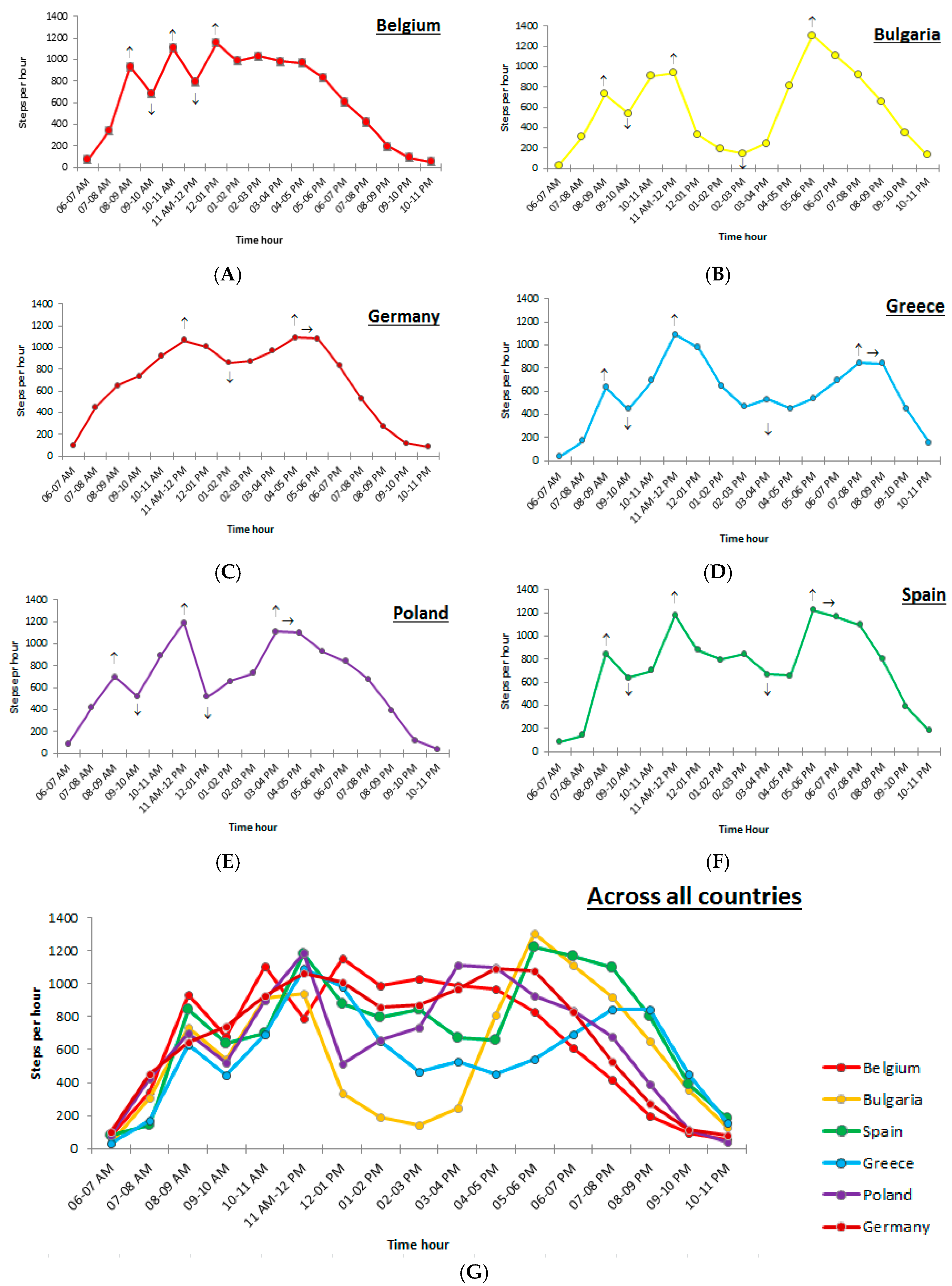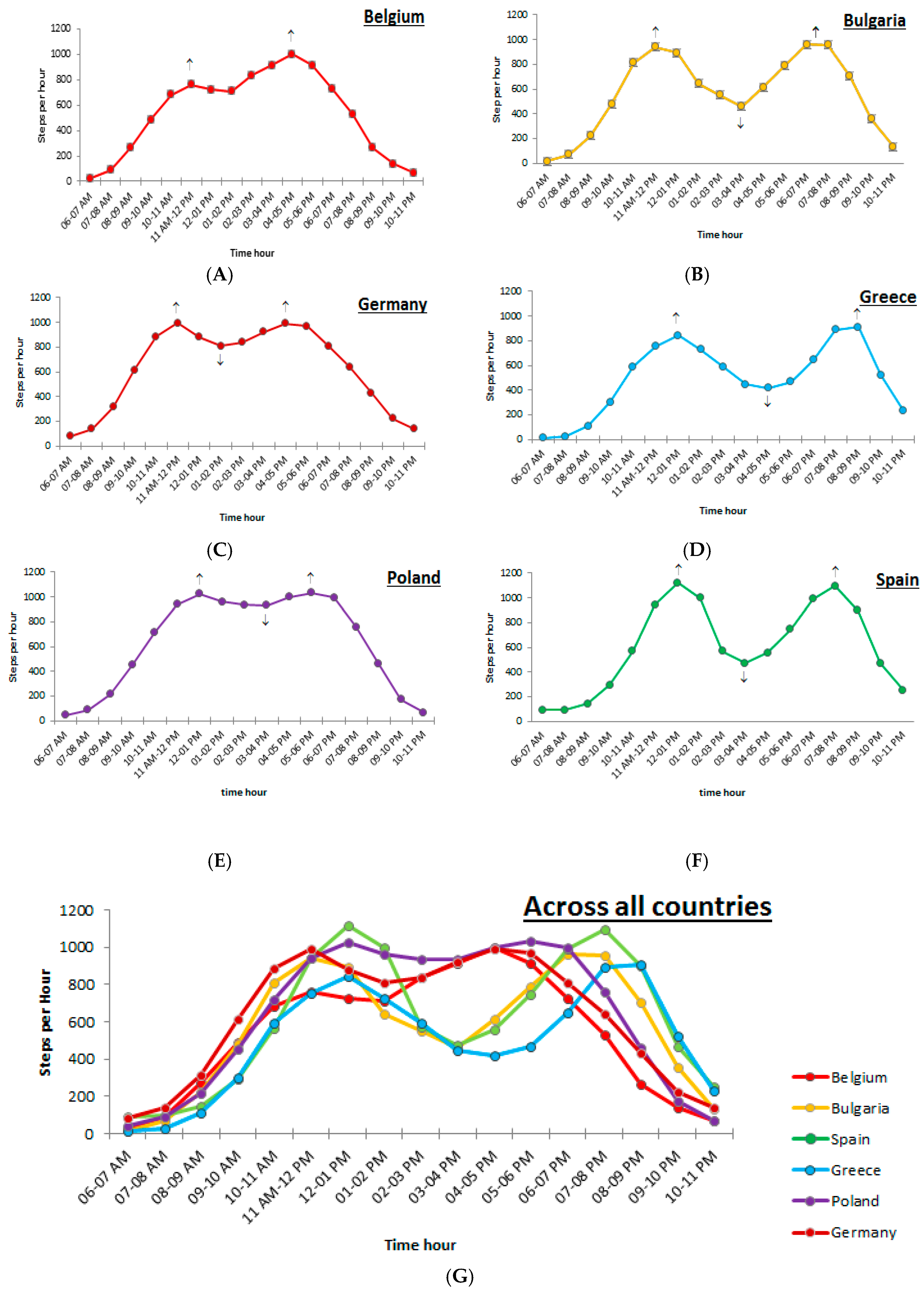Daily Patterns of Preschoolers’ Objectively Measured Step Counts in Six European Countries: Cross-Sectional Results from the ToyBox-Study
Abstract
1. Introduction
2. Methods
2.1. Sample
2.2. Measurements
2.3. Procedure
2.4. Statistical Methods
3. Results
3.1. Step Count Patterns during Weekdays
Description of Significant Peaks and Troughs Related to Daily Kindergarten Schedules
3.2. Step Count Patterns during Weekend Days
Description of Significant Peaks and Troughs
4. Discussion
5. Conclusions
Supplementary Materials
Author Contributions
Conflicts of Interest
Availability of Data and Material
Funding
Ethics Approval and Consent to Participate
Abbreviations
| PA | Physical activity |
| SES | Socio-economic status |
References
- Ministerie van Welzijn, Volksgezondheid en Gezin. Naar een Evenwichtige Voeding en Beweging. 2012. Available online: http://www.opleiding-jgz.be/bestanden/2012-2013/samenvattingsfiche.pdf (accessed on 20 May 2016).
- Tremblay, M.S.; Shephard, R.J.; Brawley, L.R.; Cameron, C.; Craig, C.L.; Duggan, M.; Esliger, D.W.; Hearst, W.; Hicks, A.; Janssen, I.; et al. Physical Activity Guidelines and Guides for Canadians: Facts and Future. Can. J. Public Health 2007, 98, S218–S224. [Google Scholar] [PubMed]
- De Craemer, M.; De Decker, E.; De Bourdeaudhuij, I.; Verloigne, M.; Manios, Y.; Cardon, G. The translation of preschoolers’ physical activity guidelines into a daily step count target. J. Sports Sci. 2015, 33, 1051–1057. [Google Scholar] [CrossRef] [PubMed]
- Hesketh, K.R.; McMinn, A.M.; Ekelund, U.; Sharp, S.J.; Collings, P.J.; Harvey, N.C.; Godfrey, K.M.; Inskip, H.M.; Cooper, C.; van Sluijs, E.M. Objectively measured physical activity in four-year-old British children: A cross-sectional analysis of activity patterns segmented across the day. Int. J. Behav. Nutr. Phys. Act. 2014, 11, 1. [Google Scholar] [CrossRef] [PubMed]
- Hesketh, K.R.; Griffin, S.J.; van Sluijs, E.M. UK Preschool-aged children’s physical activity levels in childcare and at home: A cross-sectional exploration. Int. J. Behav. Nutr. Phys. Act. 2015, 12, 123. [Google Scholar] [CrossRef] [PubMed]
- Collings, P.J.; Brage, S.; Ridgway, C.L.; Harvey, N.C.; Godfrey, K.M.; Inskip, H.M.; Cooper, C.; Wareham, N.J.; Ekelund, U. Physical activity intensity, sedentary time, and body composition in preschoolers. Am. J. Clin. Nutr. 2013, 97, 1020–1028. [Google Scholar] [CrossRef] [PubMed]
- Hinkley, T.; Salmon, J.; Okely, A.D.; Crawford, D.; Hesketh, K. Preschoolers’ Physical Activity, Screen Time, and Compliance with Recommendations. Med. Sci. Sports Exerc. 2012, 44, 458–465. [Google Scholar] [CrossRef] [PubMed]
- De Craemer, M.; Lateva, M.; Iotova, V.; De Decker, E.; Verloigne, M.; De Bourdeaudhuij, I.; Androutsos, O.; Socha, P.; Kulaga, Z.; Moreno, L.; et al. Differences in energy balance-related behaviours in European preschool children: The ToyBox-study. PLoS ONE 2015, 10, e0118303. [Google Scholar] [CrossRef] [PubMed]
- Sigmundova, D.; Sigmund, E.; Badura, P.; Vokáčová, J.; Trhlíková, L.; Bucksch, J. Weekday-weekend patterns of physical activity and screen time in parents and their pre-schoolers. BMC Public Health 2016, 16, 898. [Google Scholar] [CrossRef] [PubMed]
- Van Cauwenberghe, E.; Labarque, V.; Trost, S.G.; de Bourdeaudhuij, I.; Cardon, G. Calibration and comparison of accelerometer cut points in preschool children. Int. J. Pediatr. Obes. 2011, 6, e582–e589. [Google Scholar] [CrossRef] [PubMed]
- Brasholt, M.; Chawes, B.; Kreiner-Møller, E.; Vahlkvist, S.; Sinding, M.; Bisgaard, H. Objective assessment of levels and patterns of physical activity in preschool children. Pediatr. Res. 2013, 74, 333–338. [Google Scholar] [CrossRef] [PubMed]
- Verbestel, V.; Van Cauwenberghe, E.; De Coen, V.; Maes, L.; De Bourdeaudhuij, I.; Cardon, G. Within- and between-day variability of objectively measured physical activity in preschoolers. Pediatr. Exerc. Sci. 2011, 23, 366–378. [Google Scholar] [CrossRef] [PubMed]
- Van Cauwenberghe, E.; Jones, R.A.; Hinkley, T.; Crawford, D.; Okely, A.D. Patterns of physical activity and sedentary behaviour in preschool children. Int. J. Behav. Nutr. Phys. Act. 2012, 9, 138. [Google Scholar] [CrossRef] [PubMed]
- Manios, Y.; Grammatikaki, E.; Androutsos, O.; Chinapaw, M.J.; Gibson, E.L.; Buijs, G.; Iotova, V.; Socha, P.; Annemans, L.; Wildgruber, A.; et al. A systematic approach for the development of a kindergarten-based intervention for the prevention of obesity in preschool age children: The ToyBox-study. Obes. Rev. 2012, 13, 3–12. [Google Scholar] [CrossRef] [PubMed]
- European Commission. Compulsary Education in Europe. 2014–2015. Available online: http://eacea.ec.europa.eu/education/eurydice/documents/facts_and_figures/compulsory_education_EN.pdf (accessed on 12 December 2017).
- De Craemer, M.; De Decker, E.; Santos-Lozano, A.; Verloigne, M.; De Bourdeaudhuij, I.; Deforche, B.; Cardon, G. Validity of the Omron pedometer and the actigraph step count function in preschoolers. J. Sci. Med. Sport 2015, 18, 289–293. [Google Scholar] [CrossRef] [PubMed]
- Brug, J.; van Stralen, M.M.; Chinapaw, M.J.; De Bourdeaudhuij, I.; Lien, N.; Bere, E.; Singh, A.S.; Maes, L.; Moreno, L.; Jan, N.; et al. Differences in weight status and energy-balance related behaviours according to ethnic background among adolescents in seven countries in Europe: The ENERGY-project. Pediatr. Obes. 2012, 7, 399–411. [Google Scholar] [CrossRef] [PubMed]
- Penpraze, V.; Reilly, J.; MacLean, C.; Montgomery, C.; Kelly, L.; Paton, J.; Aitchison, T.; Grant, S. Monitoring of physical activity in young children: How much is enough? Pediatr. Exerc. Sci. 2006, 18, 483–491. [Google Scholar] [CrossRef]
- Rowe, D.A.; Mahar, M.T.; Raedeke, T.D.; Lore, J. Measuring physical activity in children with pedometers: Reliability, reactivity, and replacement of missing data. Pediatr. Exerc. Sci. 2004, 16, 343–354. [Google Scholar] [CrossRef]
- D’Haese, S.; van Dyck, D.; de Bourdeaudhuij, I.; Deforche, B.; Cardon, G. The association between the parental perception of the physical neighborhood environment and children’s location-specific physical activity. BMC Public Health 2015, 15, 565. [Google Scholar] [CrossRef] [PubMed]
- Van Dyck, D.; Sallis, J.F.; Cardon, G.; Deforche, B.; Adams, M.A.; Geremia, C.; De Bourdeaudhuij, I. Associations of neighborhood characteristics with active park use: An observational study in two cities in the USA and Belgium. Int. J. Health Geogr. 2013, 12, 26. [Google Scholar] [CrossRef] [PubMed]
- Ministerium für Kultus, Jugend und Sport (Ed.) Bildungs- und Erziehungspläne: Orientierungsplan für Bildung und Erziehung für die Baden-Württembergischen Kindergärten: Pilotphase; Cornelsen: Berlin, Germany, 2007. [Google Scholar]
- WHO Europe. Spain: Physical Activity Factsheet. Available online: http://www.euro.who.int/__data/assets/pdf_file/0008/288125/SPAIN-Physical-Activity-Factsheet.pdf (accessed on 22 February 2017).
- Trost, S.G.; Rosenkranz, R.R.; Dzewaltowski, D. Physical activity levels among children attending after-school programs. Med. Sci. Sports Exerc. 2008, 40, 622–629. [Google Scholar] [CrossRef] [PubMed]
- Gray, C.; Gibbons, R.; Larouche, R.; Sandseter, E.B.; Bienenstock, A.; Brussoni, M.; Chabot, G.; Herrington, S.; Janssen, I.; Pickett, W.; et al. What Is the Relationship between Outdoor Time and Physical Activity, Sedentary Behaviour, and Physical Fitness in Children? A Systematic Review. Int. J. Environ. Res. Public Health 2015, 12, 6455–6474. [Google Scholar] [CrossRef] [PubMed]
- Deforche, B.; De Bourdeaudhuij, I.; D’hondt, E.; Cardon, G. Objectively measured physical activity, physical activity related personality and body mass index in 6- to 10-year-old children: A cross-sectional study. Int. J. Behav. Nutr. Phys. Act. 2009, 6, 25. [Google Scholar] [CrossRef] [PubMed]
- Trost, S.G.; Fees, B.; Dzewaltowski, D. Feasibility and efficacy of a “move and learn” physical activity curriculum in preschool children. J. Phys. Act. Health 2008, 5, 88–103. [Google Scholar] [CrossRef] [PubMed]
- Wadsworth, D.D.; Robinson, L.E.; Beckham, K.; Webster, K. Break for Physical Activity: Incorporating Classroom-Based Physical Activity Breaks into Preschools. Early Child. Educ. J. 2012, 39, 391–395. [Google Scholar] [CrossRef]
- Cardon, G.M.; de Bourdeaudhuij, I.M. Are preschool children active enough? Objectively measured physical activity levels. Res. Q. Exerc. Sport 2008, 79, 326–332. [Google Scholar] [CrossRef] [PubMed]
- Papatheodorou, T. (Ed.) Debates on Early Childhood Policies and Practices: Global Snapshots of Pedagogical Thinking and Encounters; Routledge: London, UK, 2012. [Google Scholar]
- Ward, T.M.; Gay, C.; Anders, T.F.; Alkon, A.; Lee, K.A. Sleep and napping patterns in 3-to-5-year old children attending full-day childcare centers. J. Pediatr. Psychol. 2008, 33, 666–672. [Google Scholar] [CrossRef] [PubMed]
- Oliver, M.; Schofield, G.M.; Kolt, G.S.; Schluter, P.J. Pedometer accuracy in physical activity assessment of preschool children. J. Sci. Med. Sport 2007, 10, 303–310. [Google Scholar] [CrossRef] [PubMed]


| Country | n | Mean Age in Years (±SD) | Boys (%) | Low Educational Level Mother (%) (≤14 Years of School Education) |
|---|---|---|---|---|
| Belgium | 642 | 4.4 (±0.5) | 54.1 | 33.4 |
| Bulgaria | 446 | 4.9 (±0.3) | 47.8 | 41.3 |
| Germany | 396 | 4.5 (±0.6) | 51.0 | 54.0 |
| Greece | 515 | 4.9 (±0.3) | 50.9 | 49.7 |
| Poland | 1069 | 4.9 (±0.3) | 53.6 | 21.0 |
| Spain | 510 | 4.9 (±0.3) | 53.9 | 35.6 |
| Total | 3578 | 4.8 (±0.4) | 52.3 | 35.5 |
| Gender | N | Average Number of Step Counts (±SD) | |
|---|---|---|---|
| Weekdays | Boys | 1870 | 11,169 (±3364) * |
| Girls | 1704 | 9970 (±3001) * | |
| Weekend days | Boys | 1829 | 10,164 (±3894) * |
| Girls | 1661 | 9288 (±3549) * |
| Belgium | Bulgaria | Germany | Greece | Poland | Spain | |
|---|---|---|---|---|---|---|
| Peak 1 | 931 + | 734 + | 1065 ++ | 632 + | 697 + | 845 + |
| Trough 1 | 681 − | 542 − | 860 − − | 446 − | 523 − | 640 − |
| Peak 2 | 1104 $ | 940 ++ | 1089 +++ | 1090 ++ | 1188 ++ | 1178 ++ |
| Trough 2 | 791 $ | 145 − − | - | 529 − − | 515 − − | 670 − − |
| Peak 3 | 1154 ++ | 1360 +++ | - | 845 +++ | 1112 +++ | 1224 +++ |
| Belgium | Bulgaria | Germany | Greece | Poland | Spain | |
|---|---|---|---|---|---|---|
| Peak 1 | - | 941 | 993 | 842 | 1022 | 1119 |
| Trough | - | 459 | 807 | 417 | 933 | 473 |
| Peak 2 | - | 961 | 990 | 909 | 1032 | 1093 |
© 2018 by the authors. Licensee MDPI, Basel, Switzerland. This article is an open access article distributed under the terms and conditions of the Creative Commons Attribution (CC BY) license (http://creativecommons.org/licenses/by/4.0/).
Share and Cite
Van Stappen, V.; Van Dyck, D.; Latomme, J.; De Bourdeaudhuij, I.; Moreno, L.; Socha, P.; Iotova, V.; Koletzko, B.; Manios, Y.; Androutsos, O.; et al. Daily Patterns of Preschoolers’ Objectively Measured Step Counts in Six European Countries: Cross-Sectional Results from the ToyBox-Study. Int. J. Environ. Res. Public Health 2018, 15, 291. https://doi.org/10.3390/ijerph15020291
Van Stappen V, Van Dyck D, Latomme J, De Bourdeaudhuij I, Moreno L, Socha P, Iotova V, Koletzko B, Manios Y, Androutsos O, et al. Daily Patterns of Preschoolers’ Objectively Measured Step Counts in Six European Countries: Cross-Sectional Results from the ToyBox-Study. International Journal of Environmental Research and Public Health. 2018; 15(2):291. https://doi.org/10.3390/ijerph15020291
Chicago/Turabian StyleVan Stappen, Vicky, Delfien Van Dyck, Julie Latomme, Ilse De Bourdeaudhuij, Luis Moreno, Piotr Socha, Violeta Iotova, Berthold Koletzko, Yannis Manios, Odysseas Androutsos, and et al. 2018. "Daily Patterns of Preschoolers’ Objectively Measured Step Counts in Six European Countries: Cross-Sectional Results from the ToyBox-Study" International Journal of Environmental Research and Public Health 15, no. 2: 291. https://doi.org/10.3390/ijerph15020291
APA StyleVan Stappen, V., Van Dyck, D., Latomme, J., De Bourdeaudhuij, I., Moreno, L., Socha, P., Iotova, V., Koletzko, B., Manios, Y., Androutsos, O., Cardon, G., & De Craemer, M. (2018). Daily Patterns of Preschoolers’ Objectively Measured Step Counts in Six European Countries: Cross-Sectional Results from the ToyBox-Study. International Journal of Environmental Research and Public Health, 15(2), 291. https://doi.org/10.3390/ijerph15020291









